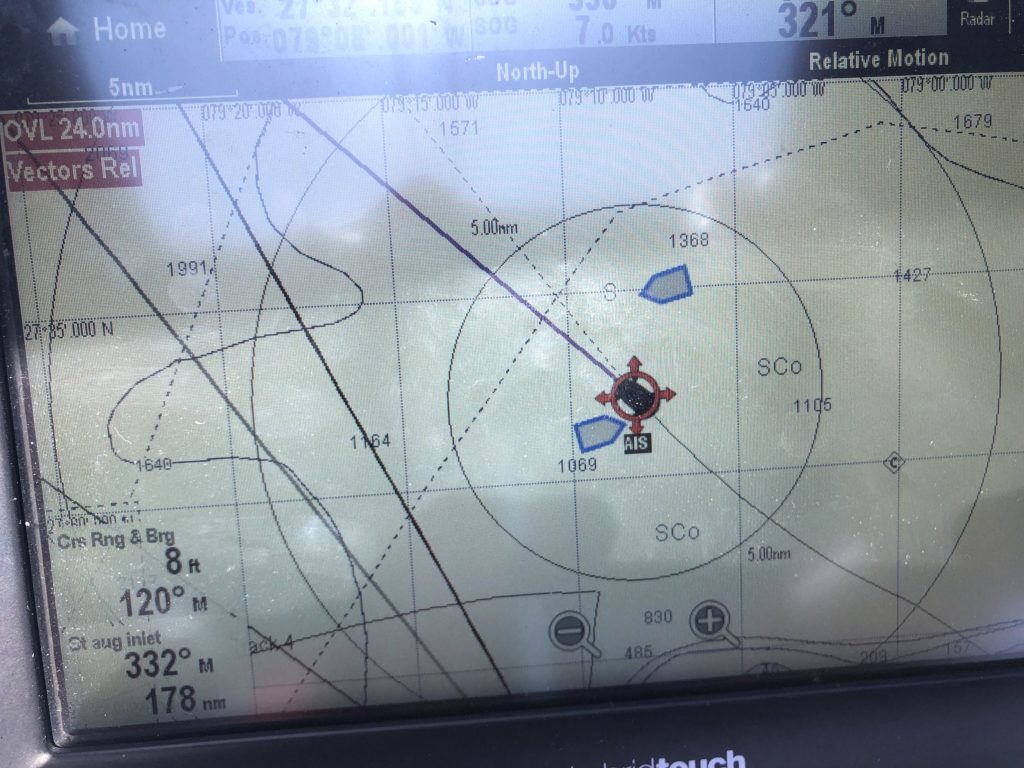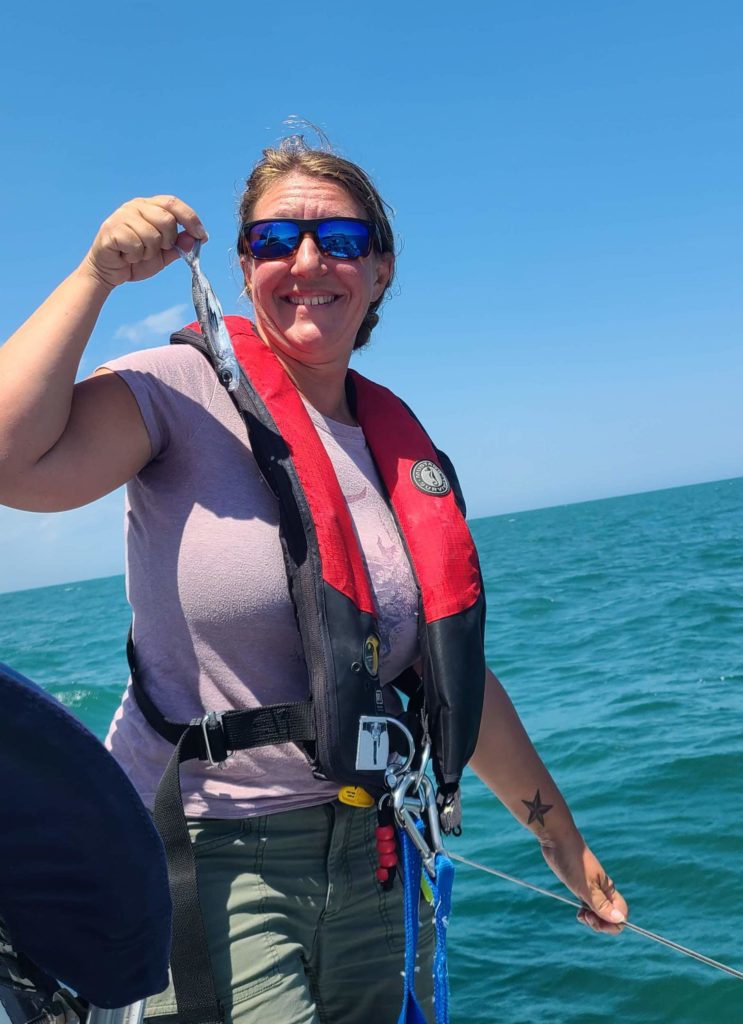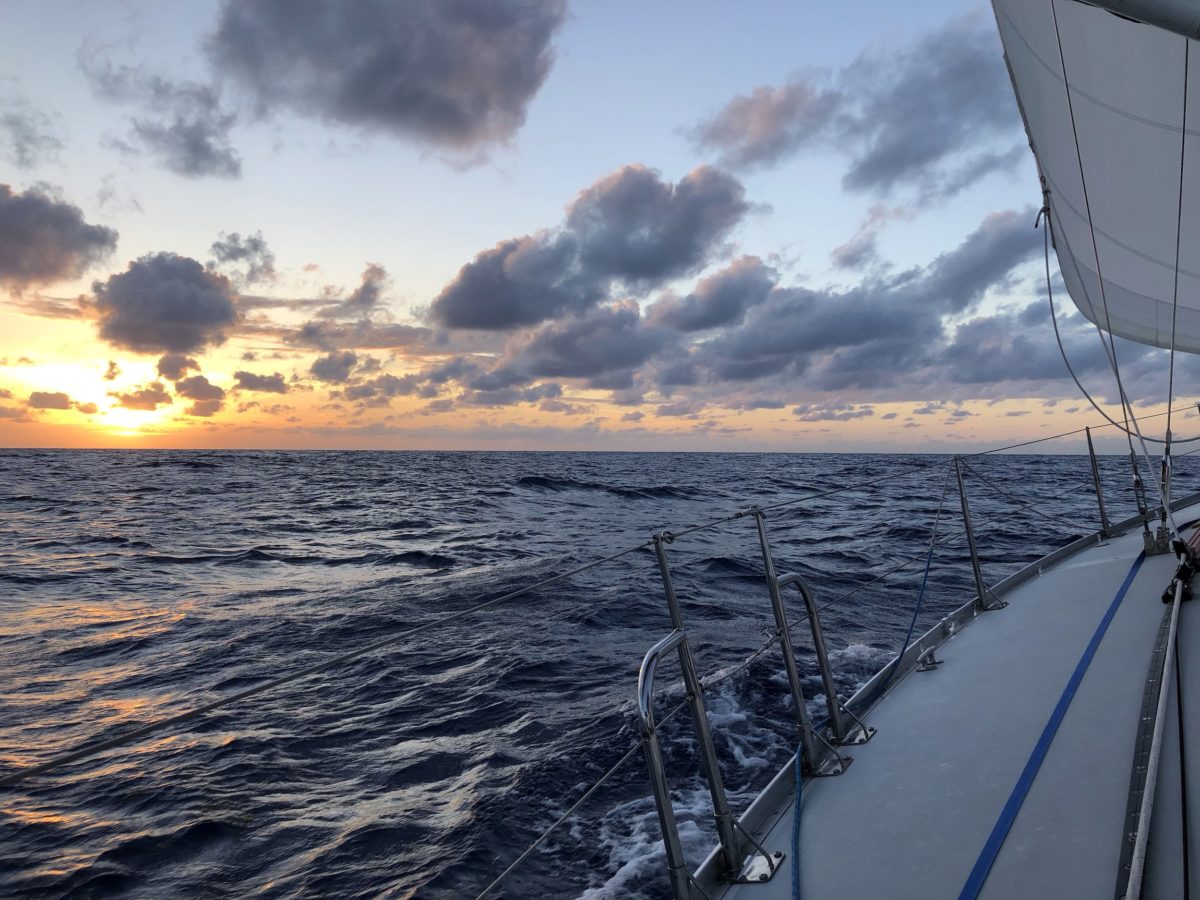With a short weather window to get to Saint Augustine, we were up well before dawn and hauled anchor just after 5am. As the sun came up, we popped the chute and took off. With 8-10kts of breeze, Windara ate it up, and it was fun to see how she performed under spinnaker and main with more wind – her racing lineage was obvious. We had around an hour of perfect sailing before a squall popped up behind us and the wind built into the mid teens, which is a little beyond that sail’s range. By the time Chris was ready on the bow and Laura was at the helm, it was gusting up into the high teens, making the takedown challenging. I had to keep calling minor course changes, bearing off to relieve pressure as it gusted up and returning to course when it settled, plus keep eyes on the foredeck so I could manage the sheets. Somehow the starboard sheet ended up under the bow (I assume in a higher gust) and as we worked the sock down, Chris kept calling for an ease. Before I knew it, the bitter end of the port sheet slid through my hand, trailing uselessly in the water. Despite the chaos, we got the sail wrangled and stowed at the mast behind the dinghy and sheets properly stowed. Lesson learned – that sail comes down significantly earlier in the future!
On my first watch, we passed through one of the major shipping areas, and I felt like I was playing tanker slalom. I found myself in a close crossing situation with two of them within 20 minutes of each other (under a mile CPA each), so I hailed them in turn. The closer one adjusted course to take my stern and I was able to pass astern of the other (which took three tries to hail). The waves had built along with the wind, and we had 4-6’ers with occasional 8-10’s, and “maintaining speed and course” as agreed with the two tanker captains was a relative exercise.

The rest of the day was uneventful as we worked our way out to the Stream. We had a nice steak dinner to celebrate that we were FINALLY on our way (and to keep from having to throw out three beautiful rib eyes). My next watch was from 2000-0000 (8pm-12am), and as forecast, the wind started to veer south throughout. We expected some early morning squalls, so I kept an eye on the patchy clouds that were starting to fill in and Chris and I agreed it was time to gybe out of the Gulf Stream as one cloud directly overhead began to look ominous.
One of the things I love about passagemaking is how sometimes a sailing concept I had previously theoretically understood but not quite gotten in application suddenly clicks. On this watch, I suddenly understood that as the wind built its apparent angle moved forward, and I was able to alter my course a few degrees to starboard, letting me make slightly more northerly progress. As the wind faded off, I had to bear off a few degrees to keep the sails drawing well and avoid an accidental gybe. Once it clicked, I spent the rest of my watch playing the shifts to my advantage. Just before I went off watch, I noticed the wind building from the low teens to consistent mid-teen gusts with occasional higher gusts. Normally, I wouldn’t have thought anything of it, but knowing there were squalls in the forecast, I called all hands to tuck a reef in the main.
I laid down but never really fell asleep on my off-watch, and just as I started to nod off, Laura woke me to come on deck – the squalls had formed and Chris had taken over at the helm as we played a pretty intense game of dodge squall. As the wind gusted up into the 40kt range, I was glad I called for that reef earlier. I had gotten us free of the Gulf Stream late in my watch, and we somehow managed to slip between the two cells, only seeing a brief period of high winds and heavy rain.
In the middle of dodging squalls, I had to go below and gather any of the remaining food we weren’t allowed to bring into the US, as we were approaching the limit where we were able to legally dump overboard. I hated throwing all that stuff overboard, both because I hate the waste and I hate dumping anything in the ocean that doesn’t belong there. But the alternative is a hefty fine if Customs comes out and finds fruit, dairy and meats aboard that aren’t clearly from the US, and it wasn’t worth the risk. Fortunately we’d eaten a good amount of what we’d bought and of what remained, much was clearly labeled as a product of the USA. Between the storm, my exhaustion, the heat below (being in full foulies didn’t help), the smell of all the food, and how long it took to root around in the fridge using a red headlamp to avoid blinding Chris at the helm, I was more than a touch queasy. I “slept” the rest of the night in the cockpit and was pretty damn cranky when Chris woke me to take over.
The dawn watch was beautiful – conditions settled back, and while I could still see lightning out over the Gulf Stream, I got a few red patches of sunrise. I didn’t have my phone or a camera out on deck, and I enjoyed knowing that sunrise was mine alone to experience. The waves subsided until they were just gentle occasional rollers on an otherwise mirror-like sea. There were a bunch of sport fishers out, but even with all the traffic, it was peaceful and reminded me what I love about open ocean sailing. I noticed a set of flying fish fins (although I prefer to call them wings) back by the wheel, but I couldn’t find their unfortunate previous owner.
After not having slept all night, I was exhausted and was glad when Laura relieved my watch. I crashed as soon as I got below and didn’t get up until almost 10. We slowed down a bit to avoid getting into Saint Augustine too early – we wanted to try to come into our slip as close to slack as possible. As we drifted along, I found the poor flying fish that had taken his final flight onto our starboard rail. I was, perhaps, a bit loopy and decided that our new deceased friend would be named Fred. I properly eulogized him (“Fred’s dead baby. Fred’s dead.” a la Bruce Willis as Butch in Pulp Fiction) and sent him back from whence he came, significantly worse for the wear.

We lowered sail and raised the Q flag just north of the Bridge of Lions, passed through and then motored around south of the bridge to kill some time. I set up the lines and fenders and spent some time getting the boat back in order. I’m always amazed how much there is to put away after an offshore passage.
Docking was hard with the wind and current up, and it didn’t go as smoothly as we would have liked – but all’s well that ends well – no humans or boats were harmed. We checked back into the US using the CBP Roam app and were granted entry within minutes with no video or in-person inspection. It’s bittersweet to be back in the States, but I’m so glad we finally got our window and I’m looking forward to spending some time in St. Augustine and the rest of our travels up the coast.
Thanks to Laura Olsen for her photo contributions!








2 replies on “USA or Bust (For Real, This Time)”
You guys certainly get the bad weather passages!!!
We do have our fair share (or more than our fair share?) of spicy passages! One of the joys of having to balance work and travel, I suppose!